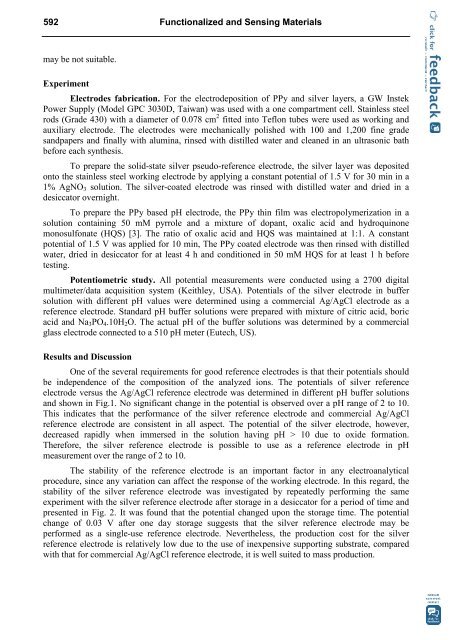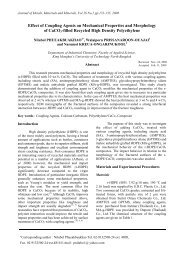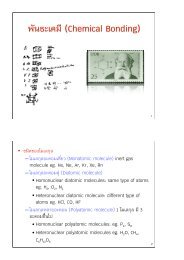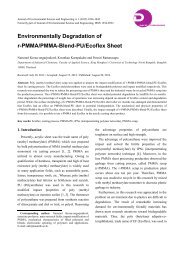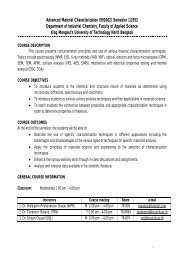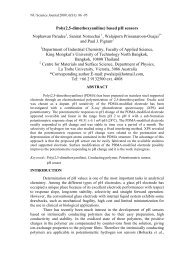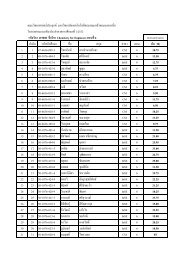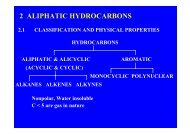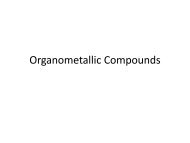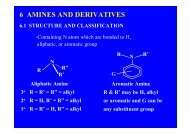All-solid-state pH Sensor Based on Conducting Polymer W ...
All-solid-state pH Sensor Based on Conducting Polymer W ...
All-solid-state pH Sensor Based on Conducting Polymer W ...
You also want an ePaper? Increase the reach of your titles
YUMPU automatically turns print PDFs into web optimized ePapers that Google loves.
592 Functi<strong>on</strong>alized and Sensing Materials<br />
may be not suitable.<br />
Experiment<br />
Electrodes fabricati<strong>on</strong>. For the electrodepositi<strong>on</strong> of PPy and silver layers, a GW Instek<br />
Power Supply (Model GPC 3030D, Taiwan) was used with a <strong>on</strong>e compartment cell. Stainless steel<br />
rods (Grade 430) with a diameter of 0.078 cm 2 fitted into Tefl<strong>on</strong> tubes were used as working and<br />
auxiliary electrode. The electrodes were mechanically polished with 100 and 1,200 fine grade<br />
sandpapers and finally with alumina, rinsed with distilled water and cleaned in an ultras<strong>on</strong>ic bath<br />
before each synthesis.<br />
To prepare the <str<strong>on</strong>g>solid</str<strong>on</strong>g>-<str<strong>on</strong>g>state</str<strong>on</strong>g> silver pseudo-reference electrode, the silver layer was deposited<br />
<strong>on</strong>to the stainless steel working electrode by applying a c<strong>on</strong>stant potential of 1.5 V for 30 min in a<br />
1% AgNO 3 soluti<strong>on</strong>. The silver-coated electrode was rinsed with distilled water and dried in a<br />
desiccator overnight.<br />
To prepare the PPy based <str<strong>on</strong>g>pH</str<strong>on</strong>g> electrode, the PPy thin film was electropolymerizati<strong>on</strong> in a<br />
soluti<strong>on</strong> c<strong>on</strong>taining 50 mM pyrrole and a mixture of dopant, oxalic acid and hydroquin<strong>on</strong>e<br />
m<strong>on</strong>osulf<strong>on</strong>ate (HQS) [3]. The ratio of oxalic acid and HQS was maintained at 1:1. A c<strong>on</strong>stant<br />
potential of 1.5 V was applied for 10 min, The PPy coated electrode was then rinsed with distilled<br />
water, dried in desiccator for at least 4 h and c<strong>on</strong>diti<strong>on</strong>ed in 50 mM HQS for at least 1 h before<br />
testing.<br />
Potentiometric study. <str<strong>on</strong>g>All</str<strong>on</strong>g> potential measurements were c<strong>on</strong>ducted using a 2700 digital<br />
multimeter/data acquisiti<strong>on</strong> system (Keithley, USA). Potentials of the silver electrode in buffer<br />
soluti<strong>on</strong> with different <str<strong>on</strong>g>pH</str<strong>on</strong>g> values were determined using a commercial Ag/AgCl electrode as a<br />
reference electrode. Standard <str<strong>on</strong>g>pH</str<strong>on</strong>g> buffer soluti<strong>on</strong>s were prepared with mixture of citric acid, boric<br />
acid and Na 3 PO 4 .10H 2 O. The actual <str<strong>on</strong>g>pH</str<strong>on</strong>g> of the buffer soluti<strong>on</strong>s was determined by a commercial<br />
glass electrode c<strong>on</strong>nected to a 510 <str<strong>on</strong>g>pH</str<strong>on</strong>g> meter (Eutech, US).<br />
Results and Discussi<strong>on</strong><br />
One of the several requirements for good reference electrodes is that their potentials should<br />
be independence of the compositi<strong>on</strong> of the analyzed i<strong>on</strong>s. The potentials of silver reference<br />
electrode versus the Ag/AgCl reference electrode was determined in different <str<strong>on</strong>g>pH</str<strong>on</strong>g> buffer soluti<strong>on</strong>s<br />
and shown in Fig.1. No significant change in the potential is observed over a <str<strong>on</strong>g>pH</str<strong>on</strong>g> range of 2 to 10.<br />
This indicates that the performance of the silver reference electrode and commercial Ag/AgCl<br />
reference electrode are c<strong>on</strong>sistent in all aspect. The potential of the silver electrode, however,<br />
decreased rapidly when immersed in the soluti<strong>on</strong> having <str<strong>on</strong>g>pH</str<strong>on</strong>g> > 10 due to oxide formati<strong>on</strong>.<br />
Therefore, the silver reference electrode is possible to use as a reference electrode in <str<strong>on</strong>g>pH</str<strong>on</strong>g><br />
measurement over the range of 2 to 10.<br />
The stability of the reference electrode is an important factor in any electroanalytical<br />
procedure, since any variati<strong>on</strong> can affect the resp<strong>on</strong>se of the working electrode. In this regard, the<br />
stability of the silver reference electrode was investigated by repeatedly performing the same<br />
experiment with the silver reference electrode after storage in a desiccator for a period of time and<br />
presented in Fig. 2. It was found that the potential changed up<strong>on</strong> the storage time. The potential<br />
change of 0.03 V after <strong>on</strong>e day storage suggests that the silver reference electrode may be<br />
performed as a single-use reference electrode. Nevertheless, the producti<strong>on</strong> cost for the silver<br />
reference electrode is relatively low due to the use of inexpensive supporting substrate, compared<br />
with that for commercial Ag/AgCl reference electrode, it is well suited to mass producti<strong>on</strong>.


